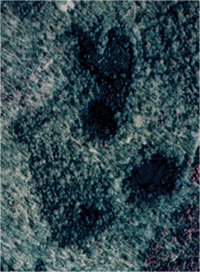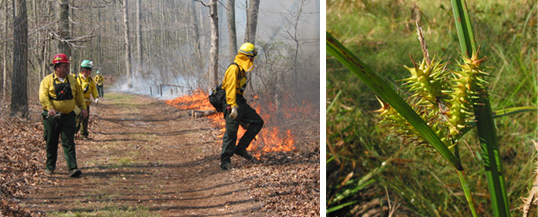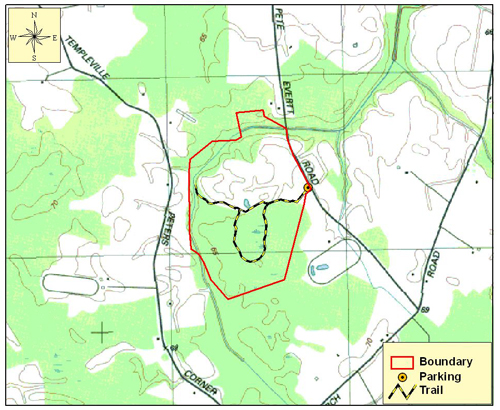Andover Flatwoods, Queen Anne's County
 Andover Flatwoods Natural Area contains an unusually shaped Carolina Bay, reminiscent of a long-eared rabbit. Typically, Carolina Bays are round or oval shaped depressions that hold water for only part of the year. Due to their seasonal nature, these distinctive areas support a variety of rare species as well as hordes of breeding amphibians. At Andover Flatwoods, the "head" of the rabbit is a typical depression, but the "ears" are shallow and gently sloping flatwoods extending from the depression. How the flatwoods "ears" formed is not known, but they increase the biological diversity of the Carolina Bay by providing wetland habitat conditions different from the depression. This diversity of habitats is important for the conservation of two rare plants: the giant sedge (Carex gigantea) and the pinwheel-like featherfoil (Hottonia inflata).
Andover Flatwoods Natural Area contains an unusually shaped Carolina Bay, reminiscent of a long-eared rabbit. Typically, Carolina Bays are round or oval shaped depressions that hold water for only part of the year. Due to their seasonal nature, these distinctive areas support a variety of rare species as well as hordes of breeding amphibians. At Andover Flatwoods, the "head" of the rabbit is a typical depression, but the "ears" are shallow and gently sloping flatwoods extending from the depression. How the flatwoods "ears" formed is not known, but they increase the biological diversity of the Carolina Bay by providing wetland habitat conditions different from the depression. This diversity of habitats is important for the conservation of two rare plants: the giant sedge (Carex gigantea) and the pinwheel-like featherfoil (Hottonia inflata).
Seasonally flooded wetlands such as those at Andover Flatwoods provide abundant habitat for amphibians, many of which are rare or declining in number. These wetlands also offer nesting and feeding grounds to migratory waterfowl and songbirds. Deer frequent this area to feed and rest. Andover Flatwoods Natural Area was purchased in 1988 by The Nature Conservancy and subsequently sold to the Maryland Department of Natural Resources for stewardship.

What's in a Name?
The earliest use of the term "Carolina Bay" in the scientific literature is from 1895. These unusual wetlands are still sometimes referred to as "whale wallows," an old name reflecting the theory that the depressions were created by the death throes of whales left stranded in the recession of a great flood. The term "Delmarva Bay" has become popular to distinguish the much smaller Carolina Bays on the Delmarva Peninsula from Bays in the Carolinas which sometimes exceed 1km in diameter!
Beneficial Burns
When the Department of Natural Resources acquired the Andover Flatwoods property, native red maple and sweetgum were shading out the sun-loving rare species found in the Carolina Bay. Restoration efforts such as prescribed burns have placed these special wetlands on the path to recovery.

Click here for a Print Version of this map.

Directions
From the Chesapeake Bay Bridge: Travel east 9 miles on US 50/301 and stay straight on US 301 at the split. After 20 miles, turn right (east) onto MD 300 and proceed 3.4 miles to Sudlersville. Continue another 4.5 miles to Everett Road. Turn right and go 1.4 miles until you reach the gate on the right hand side. There is no sign identifying Andover Flatwoods Natural Area. Simply park along the shoulder, off the road, without blocking the gate. Access is on an old forest road, not a maintained trail. Fallen trees often lie across the road, and large pools of water occur on the old road during wet periods.


Driving directions and aerial views open with Google Maps. For the aerial view button, if an aerial view does not open by default, click on the Satellite icon in the upper right corner and Google Maps will switch to an aerial view of the Natural Area.

Acknowledgments
Scenic View of Andover Flatwoods. Photo by: W. Tyndall
Wildlife Collage One: (left to right)
Andover Flatwoods is a refuge for migratory waterfowl like this beautiful male hooded merganser. Photo by: Wikimedia Commons
Featherfoil graces the water's surface. Photo by: R.H. Wiegand
A southern leopard frog and American bullfrog mutually enjoy the sun's warmth. Photo by: John White
The unusual shape of the Carolina Bay (top, center) at Andover Flatwoods is shown in this aerial photo. Photo by: NAIP
Wildlife Collage Two: (left to right)
Ecologists carefully monitor a prescribed burn. Photo by: W. Tyndall
Once nearly wiped out by the encroachment of red maple and sweetgum trees, the rare giant sedge has made an impressive comeback, thanks to restoration efforts like prescribed burns. The sedge produces millions of seeds that are�consumed by waterfowl. Photo by: W. Tyndall